
Guide to B2B Lead Qualification Process
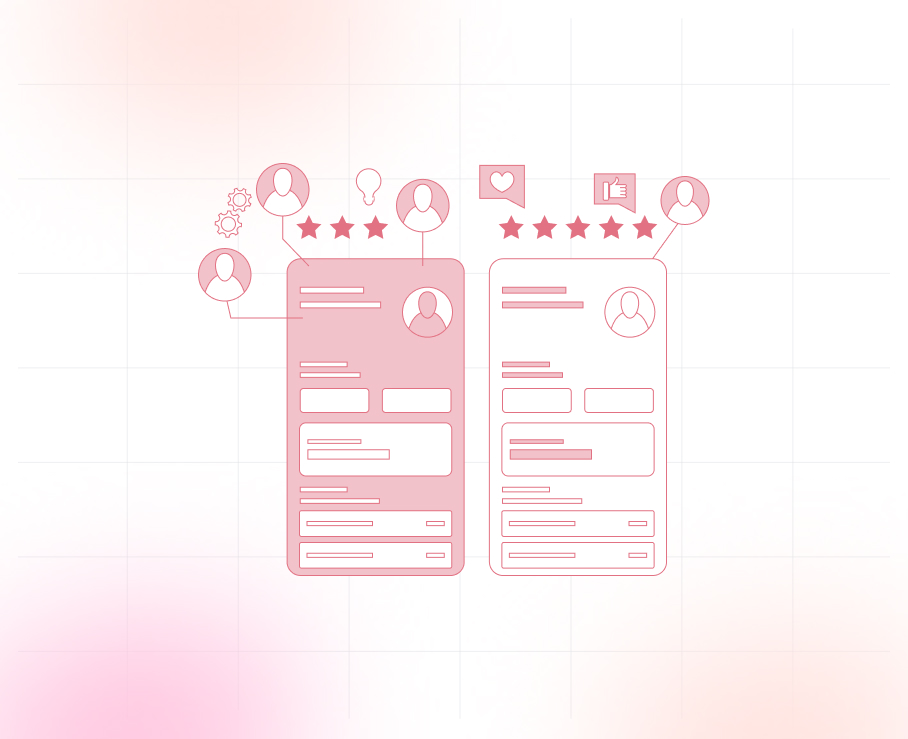
Every lead may look promising at first until you realize some will never become customers. In B2B sales, this happens more often than you might expect. That is why having a strong lead qualification process is essential. It helps you separate valuable opportunities from the rest.
Think of it like sorting seeds before planting. The better the sorting, the greater the chance of a healthy and profitable harvest.
When done right, lead qualification boosts sales productivity, improves forecasting, and ensures your team spends time where it truly matters. In fact, companies that are good at qualifying and nurturing leads generate 50% more sales-ready prospects and cut their costs by 33%.
In this guide, we’ll explain how to qualify B2B leads and improve your sales pipeline effectively.
What is B2B Lead Qualification?
B2B lead qualification is the process of evaluating potential customers to determine their likelihood of converting into paying clients.
It involves analyzing prospects based on a set of criteria that predict their readiness to make a purchase.
This allows sales teams to prioritize high-potential leads and improve conversion rates. In essence, it's about finding the "right" leads, not just more leads.
Looking to boost your lead generation? Read about: The 7 Killer B2B Lead Generation Strategies
Differentiating Between Marketing and Sales Qualified Leads
To streamline this process, it’s important to understand the distinctions between different lead types, primarily Marketing Qualified Leads (MQLs) and Sales Qualified Leads (SQLs), and the appropriate actions to take for each.
Take a look at the differences between these in the table below:
Why Lead Qualification Matters for SMEs
Lead qualification is essential for small and medium-sized enterprises (SMEs) in sectors like Managed Service Providers (MSPs), staffing, and manufacturing. These businesses often have limited resources and cannot afford to chase every lead.
By qualifying leads early, SMEs can focus their sales efforts on prospects with the highest chance of converting, saving time and budget.
Key benefits include:
- Prioritizing high-potential leads to increase sales efficiency
- Reducing wasted effort on low-value prospects
- Improving deal closure rates
- Enabling accurate sales forecasting
- Driving predictable Monthly Recurring Revenue (MRR) growth
For more insights on optimizing lead generation, read about: Outbound Lead Generation Strategies for 2025.
Let’s explore how to implement an effective lead qualification process that delivers real results.
Steps to Effectively Qualify B2B Leads
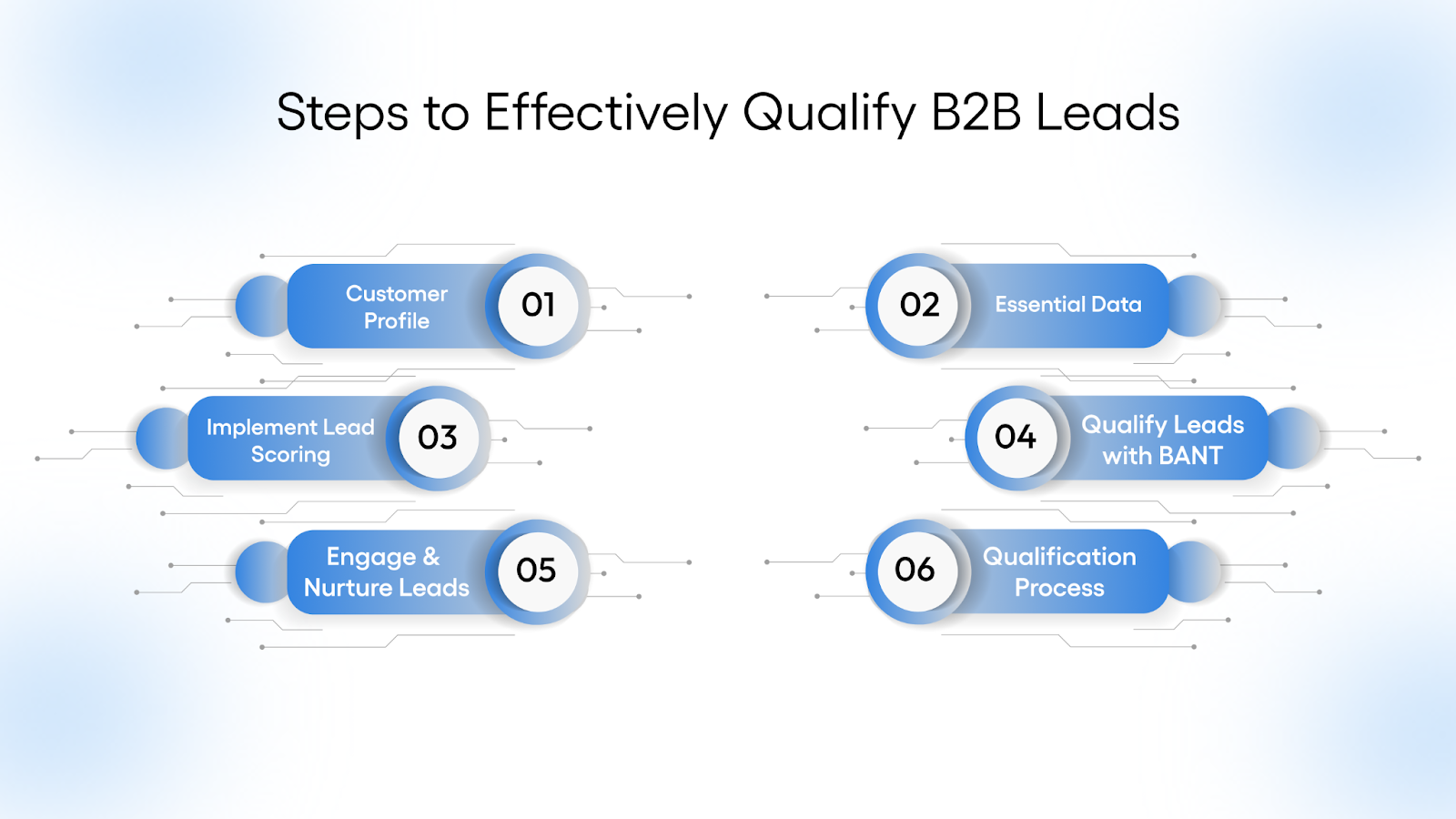
To optimize your sales pipeline and maximize conversions, it’s essential to follow a structured approach to lead qualification. Here’s a breakdown of the key steps to effectively qualify B2B leads.
1. Define Your Customer Profile
The lead qualification process begins with a clear definition of your Ideal Customer Profile (ICP). This profile outlines the type of company that is most likely to benefit from your offerings and convert into a long-term client. A well-defined ICP helps streamline prospecting, improve targeting accuracy, and ultimately boost Monthly Recurring Revenue (MRR).
- What to consider
- Industry: Which industries benefit most from your solution? For example, if you're in the tech industry, target businesses in tech, finance, or manufacturing.
- Company Size: Are you targeting small businesses or large enterprises?
- Geography: Focus on regions or countries where your solution is in demand.
- Decision-Maker Role: Identify key decision-makers like CEOs, CTOs, or VPs of Sales.
By aligning your outreach with a well-defined ICP, you can ensure that every lead in your pipeline is a strategic fit.
2. Gather Essential Data
Once your Ideal Customer Profile (ICP) is defined, the next step is collecting the right data to assess a lead’s potential for conversion. At this stage, it's crucial to focus on quality over volume, ensuring that only relevant leads enter your sales pipeline.
- Demographic Data: This includes company size, location, industry, and job roles. These parameters help filter out unqualified leads and align outreach with your ICP.
- Behavioral Data: Engagement signals like email opens, replies, and click-through patterns reveal where a lead stands in the buyer’s journey. This allows sales teams to segment leads based on interest and tailor their follow-ups accordingly.
Need help building a targeted prospect list? Read about: Effective B2B Email Lists to boost your lead qualification accuracy.
3. Implement Lead Scoring
Lead scoring is the process of assigning value to each lead based on how well they fit your ideal profile and how actively they engage with your content. This allows sales teams to prioritize outreach and focus on leads that are most likely to convert.
How to score leads
- Demographic Fit: How closely does the lead match your ICP? Assign higher scores to leads from target industries, regions, or company sizes.
- Engagement Level: Consider how often the lead interacts with your content.
Companies often struggle to set up an effective lead scoring model internally. That’s where working with a partner like The Lead Market (TLM) can make a difference. With proven experience in qualifying high-intent leads, TLM helps businesses identify Sales Qualified Leads (SQLs) faster, driving stronger conversion and a healthier sales pipeline.
4. Qualify Leads with BANT or CHAMP
Not all leads that reach your sales team are ready for engagement. To accurately evaluate whether a lead is sales-ready, use trusted qualification frameworks like BANT (Budget, Authority, Need, Timeline) or CHAMP (Challenges, Authority, Money, Prioritization).
These frameworks help sales teams understand a prospect’s needs and readiness to make a decision:
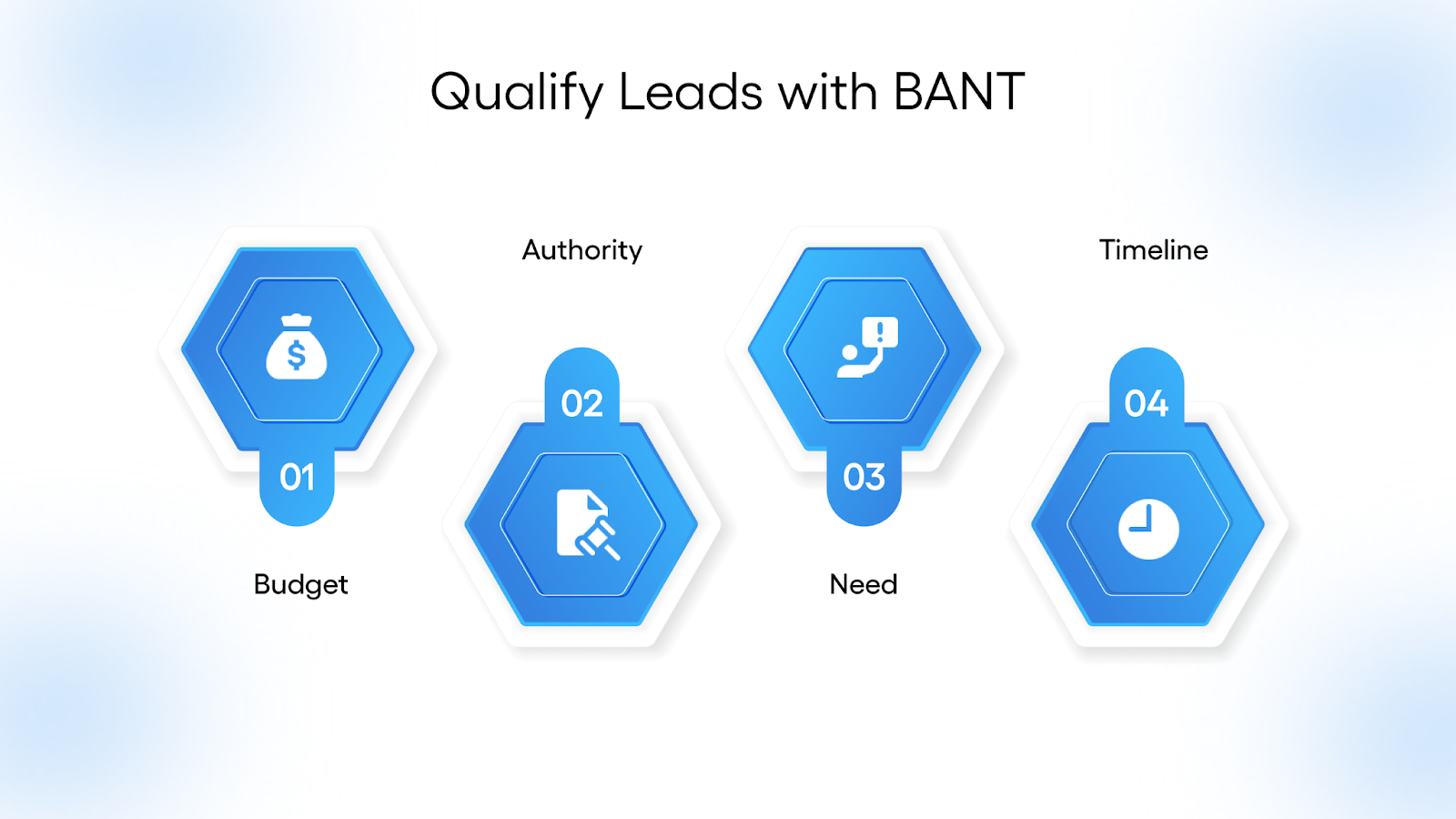
BANT
- Budget: Does the lead have the financial resources to buy?
- Authority: Are you speaking with the decision-maker?
- Need: Does the lead have a problem that your solution can solve?
- Timeline: How soon are they looking to make a purchase?
CHAMP
- Challenges: What are the key challenges they are facing?
- Authority: Who has the power to make the purchasing decision?
- Money: Do they have the budget to invest in your solution?
- Prioritization: How high of a priority is the issue for them?
Using these frameworks helps focus your sales efforts on leads with the highest potential, ensuring time and resources are invested wisely.
For a detailed step-by-step approach, read: Ultimate Lead Qualification Checklist for Success.
- Engage and Nurture Leads
Identifying high-quality leads is only the first step. Lead nurturing is essential to keep prospects engaged and guide them through the sales funnel. Email marketing plays a key role by delivering personalized messages based on each lead’s behavior and stage.
Key actions for effective nurturing include:
- Sending personalized, relevant emails.
- Using behavior-based triggers for timely follow-ups.
- Maintaining consistent, non-intrusive communication.
- Monitoring responses to refine your approach
Effective lead nurturing requires following best practices to keep prospects engaged without overwhelming them.
To learn what works and what to avoid in B2B marketing, read: dos and don’ts guide.
- Continuously Optimize the Qualification Process
Regularly reviewing and refining your lead qualification process ensures it remains effective and aligned with your business objectives. Continuous optimization helps improve conversion rates and makes better use of your sales resources.
- Feedback Loops: Gather insights from sales teams on lead quality.
- Performance Metrics: Monitor conversion rates and adjust strategies accordingly.
- Market Trends: Stay updated with industry changes that may affect lead behavior.
Implementing these steps and leveraging the provided statistics, businesses can enhance their lead qualification process, improve conversion rates, and utilize resources more efficiently.
Let’s explore how an effective lead qualification process can help your B2B sales grow more efficiently and drive better results.
Why Lead Qualification Matters for B2B Businesses
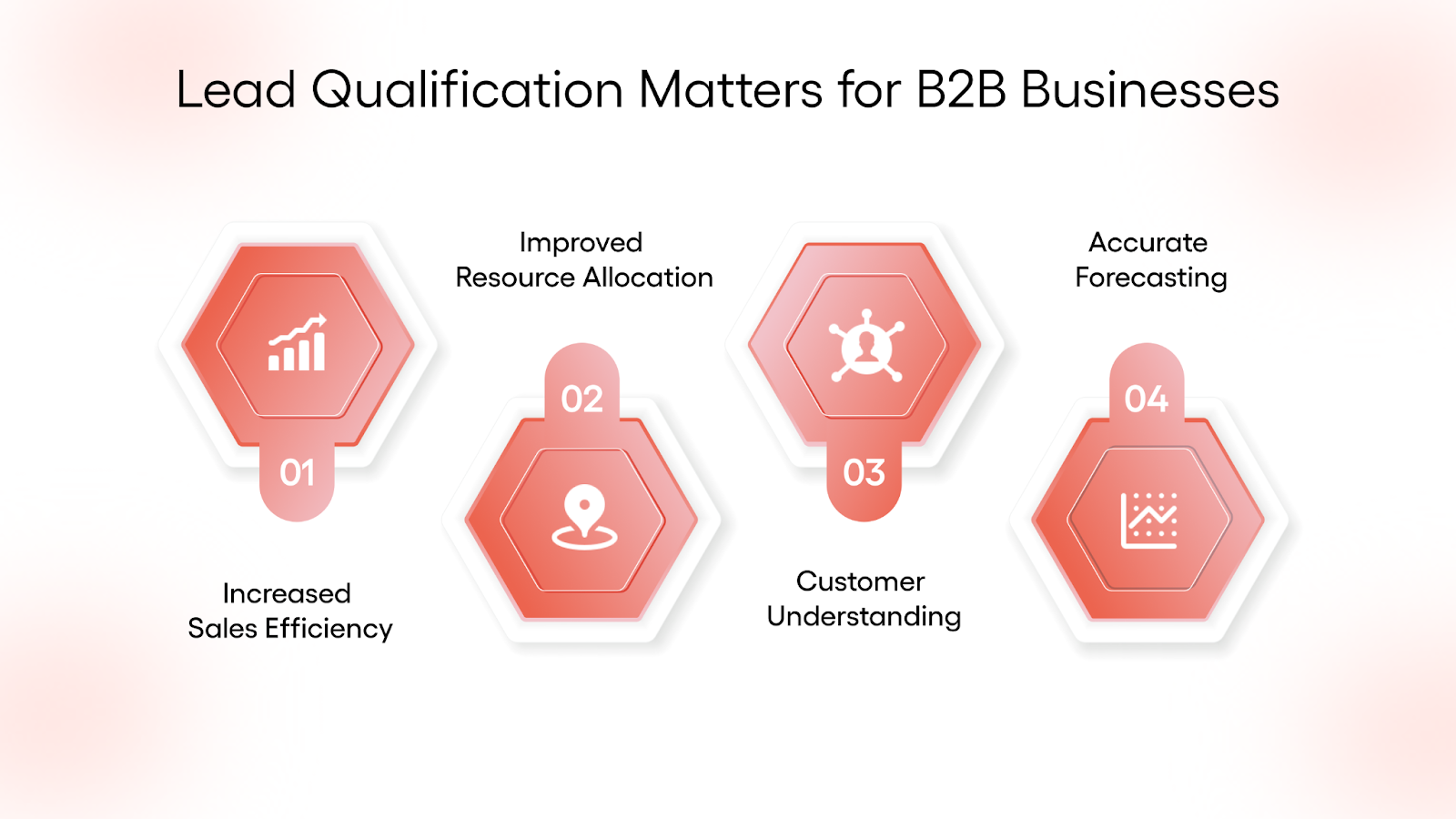
Lead qualification is more than just a step in the sales process; it is the foundation of an effective B2B sales strategy. Prioritizing leads with the highest potential to convert helps businesses boost efficiency, reduce costs, and accelerate revenue growth.
1. Increased Sales Efficiency
A structured lead qualification process enables sales teams to focus their efforts on prospects most likely to buy, reducing wasted time and improving conversion rates.
2. Improved Resource Allocation
By identifying and nurturing the most promising leads, companies can make smarter investments in marketing and sales activities, maximizing return on investment.
3. Enhanced Customer Understanding
Qualification reveals deeper customer needs and behaviors, allowing for personalized and targeted marketing that builds stronger relationships and improves retention.
4. More Accurate Forecasting
Focusing on qualified leads improves forecasting accuracy which helps businesses set realistic goals, allocate resources effectively, and make strategic decisions with confidence.
Implementing a robust lead qualification process is essential for B2B companies striving for streamlined sales operations and sustainable growth. Prioritizing quality leads drives efficiency, optimizes resources, and ultimately boosts revenue.
Common Challenges in B2B Lead Qualification and How TLM Overcomes Them
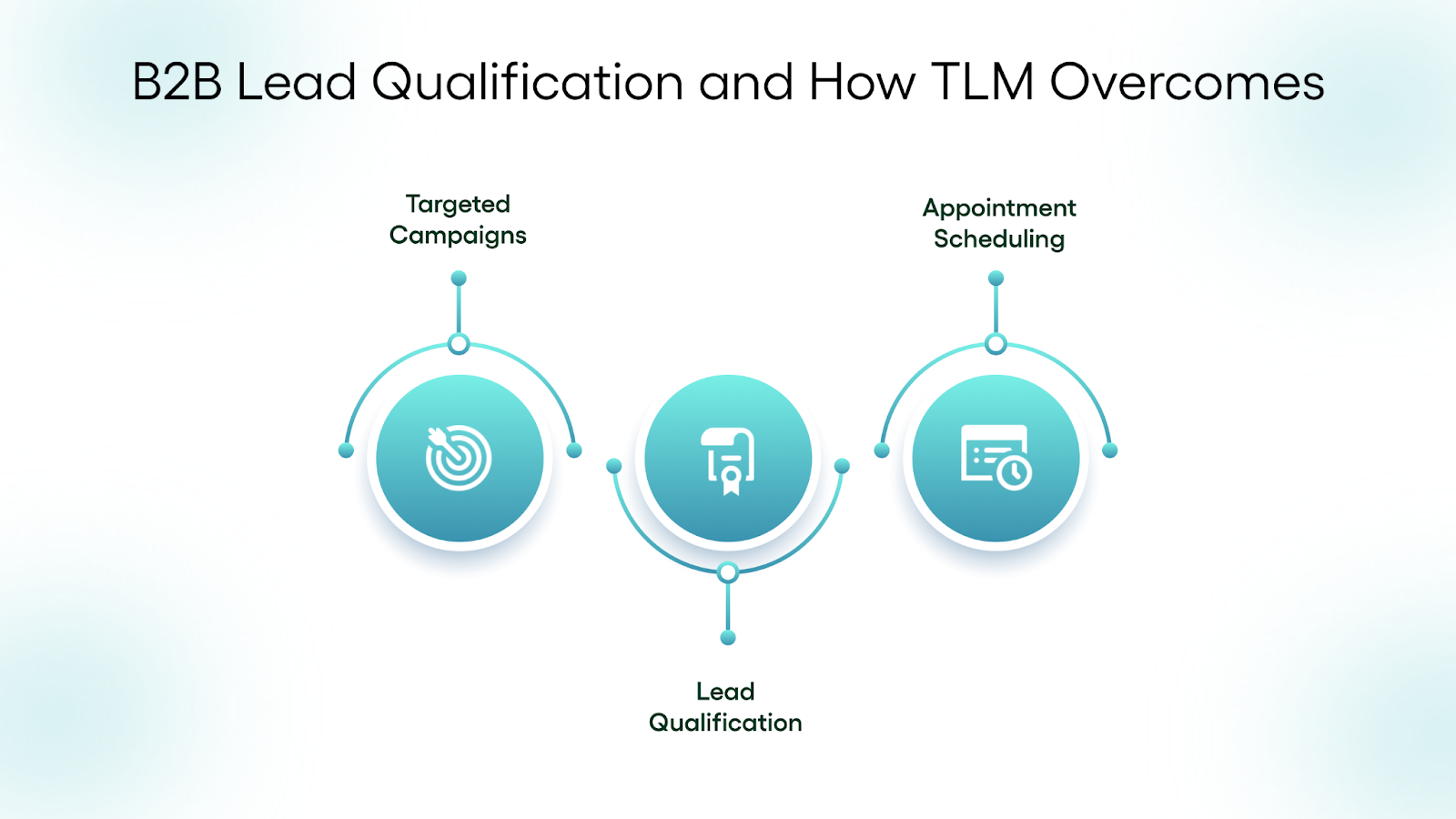
B2B lead qualification is crucial for optimizing sales efforts, but many SMEs face common pitfalls that hinder their success. Understanding these challenges and how to address them can significantly improve your lead qualification process.
Summing it Up: Why Lead Qualification is Key to B2B Sales Success
Effective lead qualification is essential for B2B sales success. You can significantly enhance your business’s sales performance by identifying and targeting the right audience, ensuring high lead quality. Additionally, optimizing resource allocation will further drive efficiency and results.
This is where TLM Inside Sales comes in. We offer comprehensive services, including Sales Qualified Lead (SQL) generation, appointment scheduling, demand generation, and targeted campaigning.
These services are designed to streamline the lead qualification process, improve conversion rates, and accelerate sales pipelines.
Ready to Build a Stronger Pipeline?
FAQs
1. How can I determine if a lead is sales-ready early in the process?
A strong lead scoring system is essential. By analyzing both demographic and behavioral data, you can prioritize leads based on their engagement with your brand. Tools like BANT or CHAMP frameworks help assess their readiness and ensure you're focusing on the most promising prospects.
2. How can lead qualification improve my marketing efforts?
By qualifying leads early in the process, you ensure that your marketing team focuses only on high-potential prospects, leading to more personalized campaigns and higher conversion rates. This targeted approach saves resources and enhances ROI on marketing efforts.
3. What are the most common mistakes to avoid in lead qualification?
Some common mistakes include misidentifying your Ideal Customer Profile (ICP), relying on inaccurate or outdated data. Regularly reviewing your qualification criteria and improving cross-team communication can help avoid these pitfalls.
4. How can I improve lead nurturing for better conversion rates?
Regular follow-ups through personalized email sequences, and retargeting strategies will keep prospects engaged. The more tailored the communication, the higher the chances of converting nurtured leads into paying customers.
Curious how to qualify leads more effectively?






